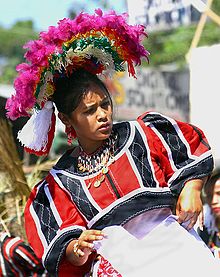Mandaya

A woman in traditional Manobo dress
|
|
| Total population | |
|---|---|
| (Unknown) | |
| Regions with significant populations | |
|
CARAGA Davao Region Northern Mindanao SOCCSKSARGEN Zamboanga Peninsula |
|
| Languages | |
| Manobo languages, Chavacano (in Zamboanga region), Cebuano, Hiligaynon, Filipino, English | |
| Religion | |
| Christianity (Roman Catholic, Protestant) and Animist | |
| Related ethnic groups | |
| Bajau people, Moro, Visayans, Filipinos, other Austronesian peoples |
The Lumad are a group of non-Muslim indigenous people in the southern Philippines. It is a Cebuano term meaning "native" or "indigenous". The term is short for Katawhang Lumad (Literally: "indigenous people"), the autonym officially adopted by the delegates of the Lumad Mindanao Peoples Federation (LMPF) founding assembly on 26 June 1986 at the Guadalupe Formation Center, Balindog, Kidapawan, Cotabato, Philippines. It is the self-ascription and collective identity of the indigenous peoples of Mindanao.
The name Lumad grew out of the political awakening among tribes during the martial law regime of President Ferdinand Marcos. It was advocated and propagated by the members and affiliates of Lumad-Mindanao, a coalition of all-Lumad local and regional organizations which formalized themselves as such in June 1986 but started in 1983 as a multi-sectoral organization. Lumad-Mindanao’s main objective was to achieve self-determination for their member-tribes or, put more concretely, self-governance within their ancestral domain in accordance with their culture and customary laws. No other Lumad organization had had the express goal in the past.
Representatives from 15 tribes agreed in June 1986 to adopt the name; there were no delegates from the three major groups of the T'boli, the Teduray. The choice of a Cebuano word was a bit ironic but they deemed it appropriate as the Lumad tribes do not have any other common language except Cebuano. This marked the first time that these tribes had agreed to a common name for themselves, distinct from that of the Moros and different from the migrant majority and their descendants.
There are many Lumad ethnolinguistic groups: Atta, Bagobo, Banwaon, B’laan, Bukidnon, Dibabawon, Higaonon, Mamanwa, Mandaya, Manguwangan, Manobo, Mansaka, Subanen, Tagakaolo, Tasaday, Tboli, Teduray, and Ubo.
...
Wikipedia
